Equity Portfolio Management Business Report: Think Big Consultancy
VerifiedAdded on 2021/05/30
|11
|2138
|74
Report
AI Summary
This report outlines a business plan for 'Think Big,' an equity portfolio management consultancy. It begins with a need analysis, identifying a gap in the market for guidance on equity trading, particularly for those interested in penny stocks. The report details the target market, primarily individuals with portfolios over AUD 5000, and emphasizes product differentiation through expertise in penny stocks. The business model involves dedicated relationship managers, research reports, and two revenue models: advance fees and profit sharing. Critical success factors include client retention and accurate advice. The report includes financial projections, marketing strategies (digital marketing, financial news ads, print media), and a discussion of the team's collaborative efforts. The conclusion underscores the role of entrepreneurship in economic growth and the potential of 'Think Big' to provide profitable investment opportunities.

Think Big
Equity portfolio management
Equity portfolio management
Paraphrase This Document
Need a fresh take? Get an instant paraphrase of this document with our AI Paraphraser
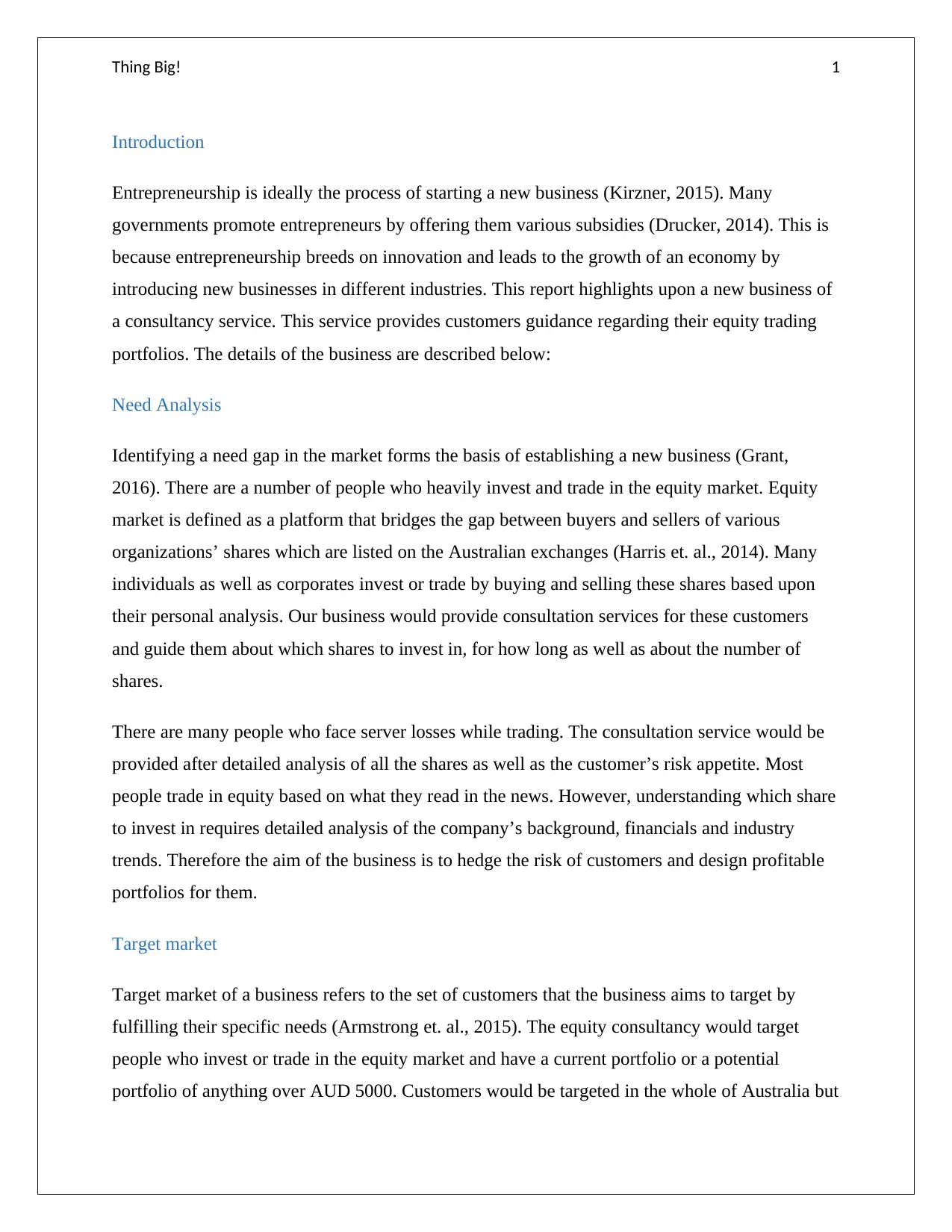
Thing Big! 1
Introduction
Entrepreneurship is ideally the process of starting a new business (Kirzner, 2015). Many
governments promote entrepreneurs by offering them various subsidies (Drucker, 2014). This is
because entrepreneurship breeds on innovation and leads to the growth of an economy by
introducing new businesses in different industries. This report highlights upon a new business of
a consultancy service. This service provides customers guidance regarding their equity trading
portfolios. The details of the business are described below:
Need Analysis
Identifying a need gap in the market forms the basis of establishing a new business (Grant,
2016). There are a number of people who heavily invest and trade in the equity market. Equity
market is defined as a platform that bridges the gap between buyers and sellers of various
organizations’ shares which are listed on the Australian exchanges (Harris et. al., 2014). Many
individuals as well as corporates invest or trade by buying and selling these shares based upon
their personal analysis. Our business would provide consultation services for these customers
and guide them about which shares to invest in, for how long as well as about the number of
shares.
There are many people who face server losses while trading. The consultation service would be
provided after detailed analysis of all the shares as well as the customer’s risk appetite. Most
people trade in equity based on what they read in the news. However, understanding which share
to invest in requires detailed analysis of the company’s background, financials and industry
trends. Therefore the aim of the business is to hedge the risk of customers and design profitable
portfolios for them.
Target market
Target market of a business refers to the set of customers that the business aims to target by
fulfilling their specific needs (Armstrong et. al., 2015). The equity consultancy would target
people who invest or trade in the equity market and have a current portfolio or a potential
portfolio of anything over AUD 5000. Customers would be targeted in the whole of Australia but
Introduction
Entrepreneurship is ideally the process of starting a new business (Kirzner, 2015). Many
governments promote entrepreneurs by offering them various subsidies (Drucker, 2014). This is
because entrepreneurship breeds on innovation and leads to the growth of an economy by
introducing new businesses in different industries. This report highlights upon a new business of
a consultancy service. This service provides customers guidance regarding their equity trading
portfolios. The details of the business are described below:
Need Analysis
Identifying a need gap in the market forms the basis of establishing a new business (Grant,
2016). There are a number of people who heavily invest and trade in the equity market. Equity
market is defined as a platform that bridges the gap between buyers and sellers of various
organizations’ shares which are listed on the Australian exchanges (Harris et. al., 2014). Many
individuals as well as corporates invest or trade by buying and selling these shares based upon
their personal analysis. Our business would provide consultation services for these customers
and guide them about which shares to invest in, for how long as well as about the number of
shares.
There are many people who face server losses while trading. The consultation service would be
provided after detailed analysis of all the shares as well as the customer’s risk appetite. Most
people trade in equity based on what they read in the news. However, understanding which share
to invest in requires detailed analysis of the company’s background, financials and industry
trends. Therefore the aim of the business is to hedge the risk of customers and design profitable
portfolios for them.
Target market
Target market of a business refers to the set of customers that the business aims to target by
fulfilling their specific needs (Armstrong et. al., 2015). The equity consultancy would target
people who invest or trade in the equity market and have a current portfolio or a potential
portfolio of anything over AUD 5000. Customers would be targeted in the whole of Australia but
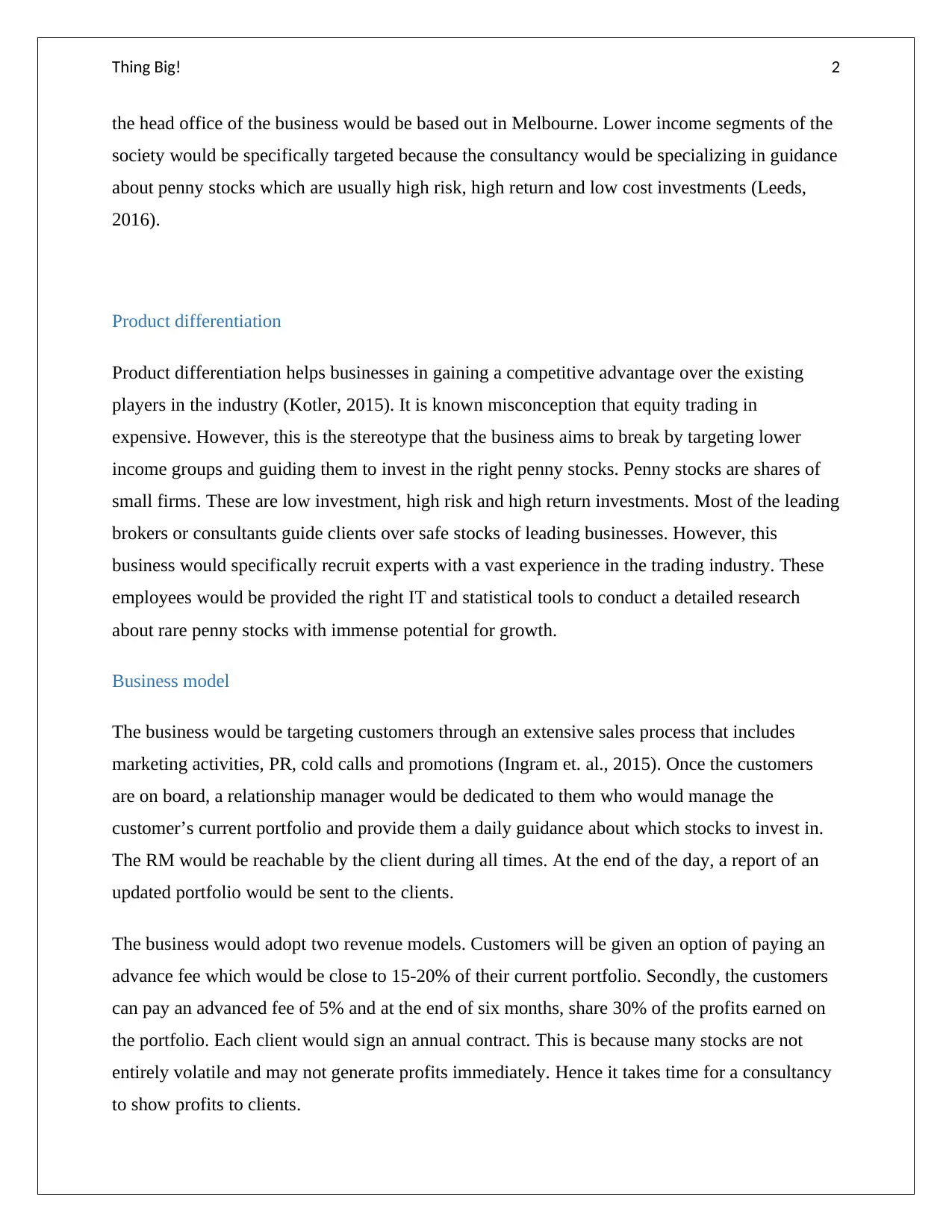
Thing Big! 2
the head office of the business would be based out in Melbourne. Lower income segments of the
society would be specifically targeted because the consultancy would be specializing in guidance
about penny stocks which are usually high risk, high return and low cost investments (Leeds,
2016).
Product differentiation
Product differentiation helps businesses in gaining a competitive advantage over the existing
players in the industry (Kotler, 2015). It is known misconception that equity trading in
expensive. However, this is the stereotype that the business aims to break by targeting lower
income groups and guiding them to invest in the right penny stocks. Penny stocks are shares of
small firms. These are low investment, high risk and high return investments. Most of the leading
brokers or consultants guide clients over safe stocks of leading businesses. However, this
business would specifically recruit experts with a vast experience in the trading industry. These
employees would be provided the right IT and statistical tools to conduct a detailed research
about rare penny stocks with immense potential for growth.
Business model
The business would be targeting customers through an extensive sales process that includes
marketing activities, PR, cold calls and promotions (Ingram et. al., 2015). Once the customers
are on board, a relationship manager would be dedicated to them who would manage the
customer’s current portfolio and provide them a daily guidance about which stocks to invest in.
The RM would be reachable by the client during all times. At the end of the day, a report of an
updated portfolio would be sent to the clients.
The business would adopt two revenue models. Customers will be given an option of paying an
advance fee which would be close to 15-20% of their current portfolio. Secondly, the customers
can pay an advanced fee of 5% and at the end of six months, share 30% of the profits earned on
the portfolio. Each client would sign an annual contract. This is because many stocks are not
entirely volatile and may not generate profits immediately. Hence it takes time for a consultancy
to show profits to clients.
the head office of the business would be based out in Melbourne. Lower income segments of the
society would be specifically targeted because the consultancy would be specializing in guidance
about penny stocks which are usually high risk, high return and low cost investments (Leeds,
2016).
Product differentiation
Product differentiation helps businesses in gaining a competitive advantage over the existing
players in the industry (Kotler, 2015). It is known misconception that equity trading in
expensive. However, this is the stereotype that the business aims to break by targeting lower
income groups and guiding them to invest in the right penny stocks. Penny stocks are shares of
small firms. These are low investment, high risk and high return investments. Most of the leading
brokers or consultants guide clients over safe stocks of leading businesses. However, this
business would specifically recruit experts with a vast experience in the trading industry. These
employees would be provided the right IT and statistical tools to conduct a detailed research
about rare penny stocks with immense potential for growth.
Business model
The business would be targeting customers through an extensive sales process that includes
marketing activities, PR, cold calls and promotions (Ingram et. al., 2015). Once the customers
are on board, a relationship manager would be dedicated to them who would manage the
customer’s current portfolio and provide them a daily guidance about which stocks to invest in.
The RM would be reachable by the client during all times. At the end of the day, a report of an
updated portfolio would be sent to the clients.
The business would adopt two revenue models. Customers will be given an option of paying an
advance fee which would be close to 15-20% of their current portfolio. Secondly, the customers
can pay an advanced fee of 5% and at the end of six months, share 30% of the profits earned on
the portfolio. Each client would sign an annual contract. This is because many stocks are not
entirely volatile and may not generate profits immediately. Hence it takes time for a consultancy
to show profits to clients.
⊘ This is a preview!⊘
Do you want full access?
Subscribe today to unlock all pages.

Trusted by 1+ million students worldwide
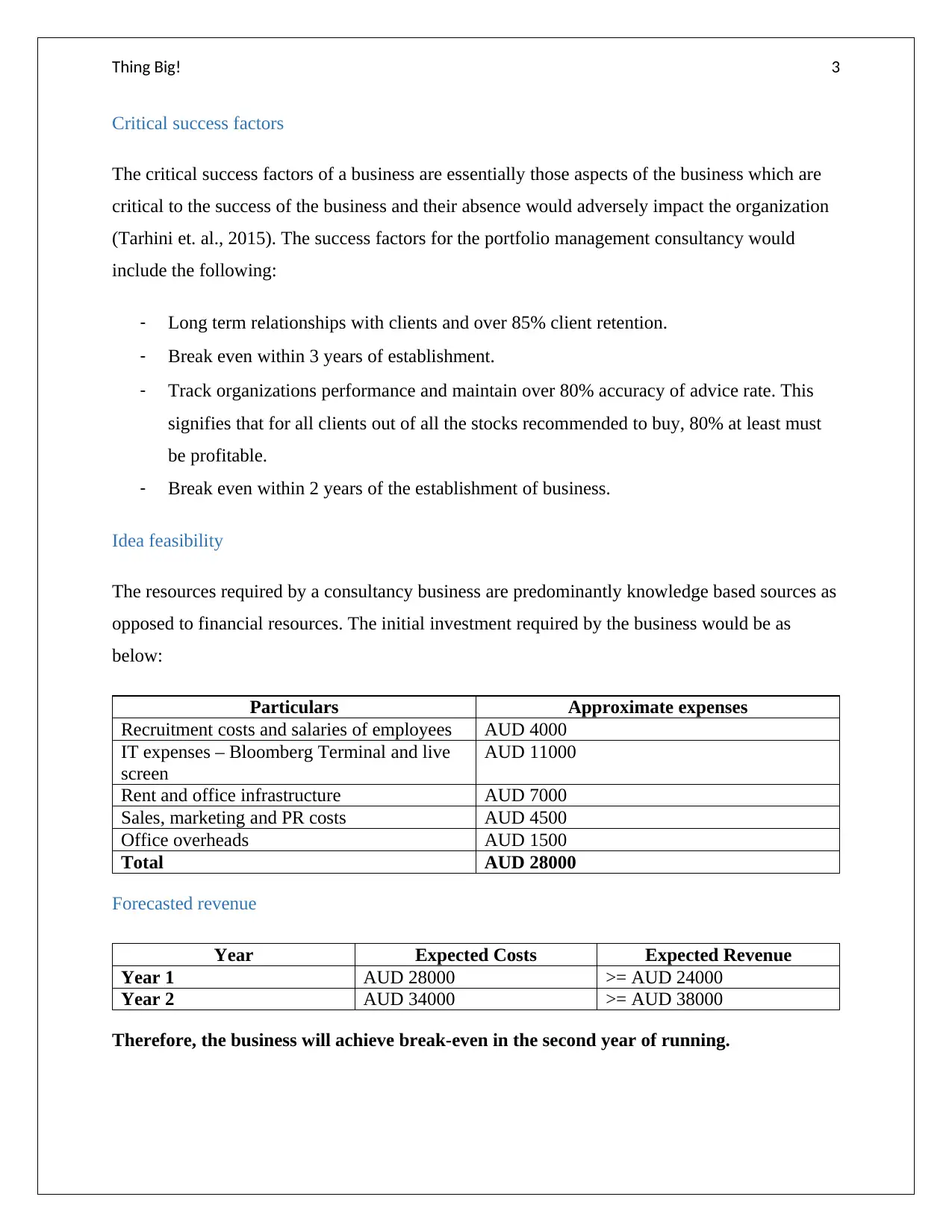
Thing Big! 3
Critical success factors
The critical success factors of a business are essentially those aspects of the business which are
critical to the success of the business and their absence would adversely impact the organization
(Tarhini et. al., 2015). The success factors for the portfolio management consultancy would
include the following:
- Long term relationships with clients and over 85% client retention.
- Break even within 3 years of establishment.
- Track organizations performance and maintain over 80% accuracy of advice rate. This
signifies that for all clients out of all the stocks recommended to buy, 80% at least must
be profitable.
- Break even within 2 years of the establishment of business.
Idea feasibility
The resources required by a consultancy business are predominantly knowledge based sources as
opposed to financial resources. The initial investment required by the business would be as
below:
Particulars Approximate expenses
Recruitment costs and salaries of employees AUD 4000
IT expenses – Bloomberg Terminal and live
screen
AUD 11000
Rent and office infrastructure AUD 7000
Sales, marketing and PR costs AUD 4500
Office overheads AUD 1500
Total AUD 28000
Forecasted revenue
Year Expected Costs Expected Revenue
Year 1 AUD 28000 >= AUD 24000
Year 2 AUD 34000 >= AUD 38000
Therefore, the business will achieve break-even in the second year of running.
Critical success factors
The critical success factors of a business are essentially those aspects of the business which are
critical to the success of the business and their absence would adversely impact the organization
(Tarhini et. al., 2015). The success factors for the portfolio management consultancy would
include the following:
- Long term relationships with clients and over 85% client retention.
- Break even within 3 years of establishment.
- Track organizations performance and maintain over 80% accuracy of advice rate. This
signifies that for all clients out of all the stocks recommended to buy, 80% at least must
be profitable.
- Break even within 2 years of the establishment of business.
Idea feasibility
The resources required by a consultancy business are predominantly knowledge based sources as
opposed to financial resources. The initial investment required by the business would be as
below:
Particulars Approximate expenses
Recruitment costs and salaries of employees AUD 4000
IT expenses – Bloomberg Terminal and live
screen
AUD 11000
Rent and office infrastructure AUD 7000
Sales, marketing and PR costs AUD 4500
Office overheads AUD 1500
Total AUD 28000
Forecasted revenue
Year Expected Costs Expected Revenue
Year 1 AUD 28000 >= AUD 24000
Year 2 AUD 34000 >= AUD 38000
Therefore, the business will achieve break-even in the second year of running.
Paraphrase This Document
Need a fresh take? Get an instant paraphrase of this document with our AI Paraphraser
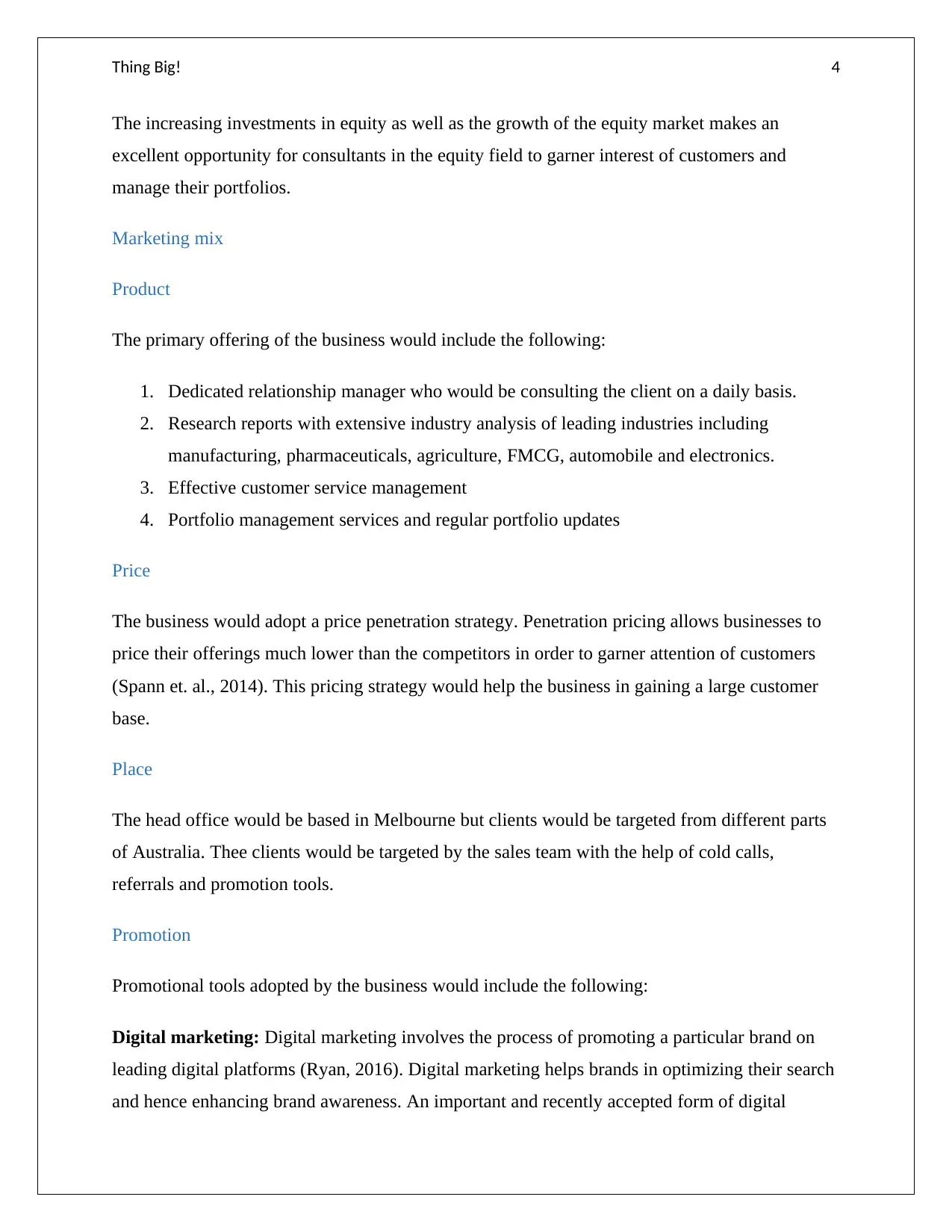
Thing Big! 4
The increasing investments in equity as well as the growth of the equity market makes an
excellent opportunity for consultants in the equity field to garner interest of customers and
manage their portfolios.
Marketing mix
Product
The primary offering of the business would include the following:
1. Dedicated relationship manager who would be consulting the client on a daily basis.
2. Research reports with extensive industry analysis of leading industries including
manufacturing, pharmaceuticals, agriculture, FMCG, automobile and electronics.
3. Effective customer service management
4. Portfolio management services and regular portfolio updates
Price
The business would adopt a price penetration strategy. Penetration pricing allows businesses to
price their offerings much lower than the competitors in order to garner attention of customers
(Spann et. al., 2014). This pricing strategy would help the business in gaining a large customer
base.
Place
The head office would be based in Melbourne but clients would be targeted from different parts
of Australia. Thee clients would be targeted by the sales team with the help of cold calls,
referrals and promotion tools.
Promotion
Promotional tools adopted by the business would include the following:
Digital marketing: Digital marketing involves the process of promoting a particular brand on
leading digital platforms (Ryan, 2016). Digital marketing helps brands in optimizing their search
and hence enhancing brand awareness. An important and recently accepted form of digital
The increasing investments in equity as well as the growth of the equity market makes an
excellent opportunity for consultants in the equity field to garner interest of customers and
manage their portfolios.
Marketing mix
Product
The primary offering of the business would include the following:
1. Dedicated relationship manager who would be consulting the client on a daily basis.
2. Research reports with extensive industry analysis of leading industries including
manufacturing, pharmaceuticals, agriculture, FMCG, automobile and electronics.
3. Effective customer service management
4. Portfolio management services and regular portfolio updates
Price
The business would adopt a price penetration strategy. Penetration pricing allows businesses to
price their offerings much lower than the competitors in order to garner attention of customers
(Spann et. al., 2014). This pricing strategy would help the business in gaining a large customer
base.
Place
The head office would be based in Melbourne but clients would be targeted from different parts
of Australia. Thee clients would be targeted by the sales team with the help of cold calls,
referrals and promotion tools.
Promotion
Promotional tools adopted by the business would include the following:
Digital marketing: Digital marketing involves the process of promoting a particular brand on
leading digital platforms (Ryan, 2016). Digital marketing helps brands in optimizing their search
and hence enhancing brand awareness. An important and recently accepted form of digital
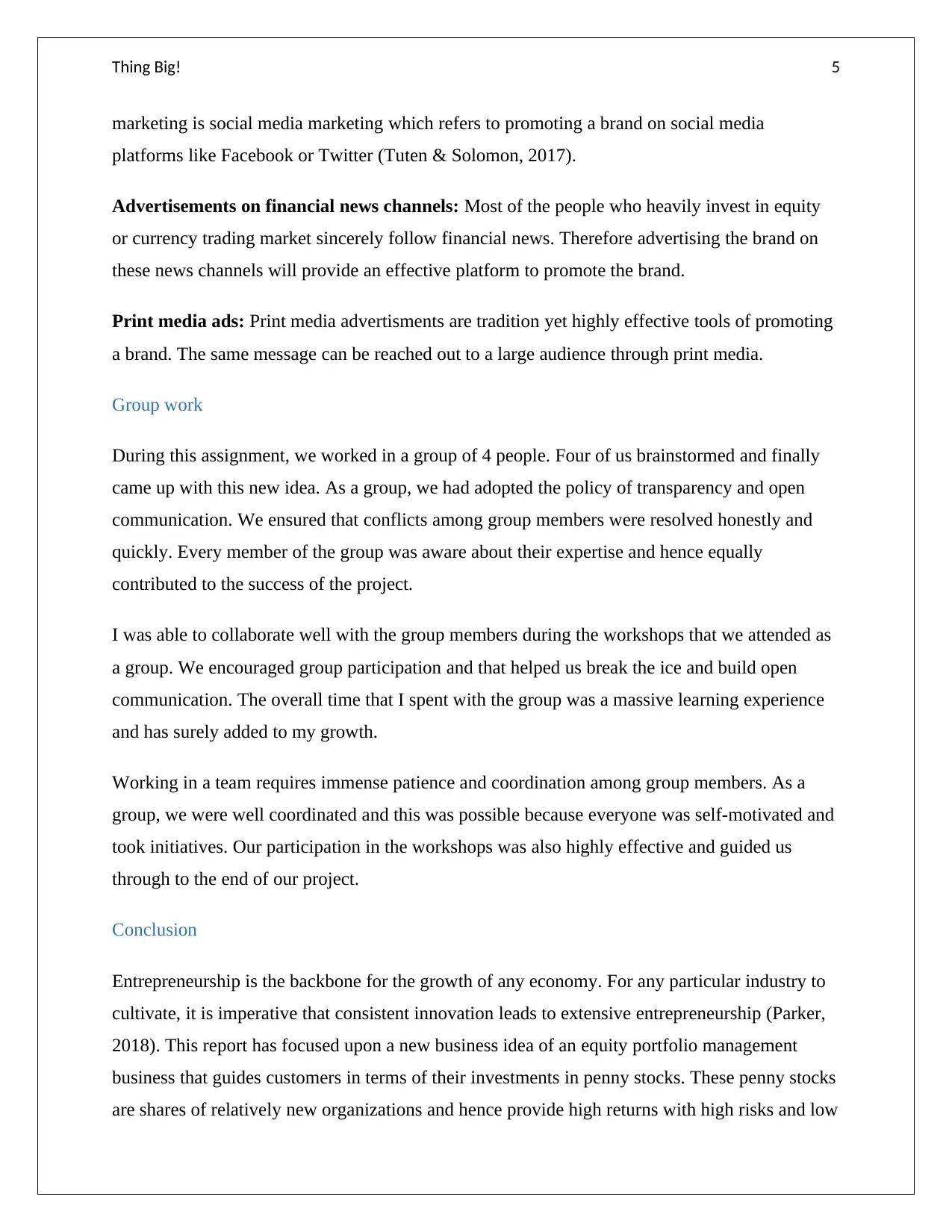
Thing Big! 5
marketing is social media marketing which refers to promoting a brand on social media
platforms like Facebook or Twitter (Tuten & Solomon, 2017).
Advertisements on financial news channels: Most of the people who heavily invest in equity
or currency trading market sincerely follow financial news. Therefore advertising the brand on
these news channels will provide an effective platform to promote the brand.
Print media ads: Print media advertisments are tradition yet highly effective tools of promoting
a brand. The same message can be reached out to a large audience through print media.
Group work
During this assignment, we worked in a group of 4 people. Four of us brainstormed and finally
came up with this new idea. As a group, we had adopted the policy of transparency and open
communication. We ensured that conflicts among group members were resolved honestly and
quickly. Every member of the group was aware about their expertise and hence equally
contributed to the success of the project.
I was able to collaborate well with the group members during the workshops that we attended as
a group. We encouraged group participation and that helped us break the ice and build open
communication. The overall time that I spent with the group was a massive learning experience
and has surely added to my growth.
Working in a team requires immense patience and coordination among group members. As a
group, we were well coordinated and this was possible because everyone was self-motivated and
took initiatives. Our participation in the workshops was also highly effective and guided us
through to the end of our project.
Conclusion
Entrepreneurship is the backbone for the growth of any economy. For any particular industry to
cultivate, it is imperative that consistent innovation leads to extensive entrepreneurship (Parker,
2018). This report has focused upon a new business idea of an equity portfolio management
business that guides customers in terms of their investments in penny stocks. These penny stocks
are shares of relatively new organizations and hence provide high returns with high risks and low
marketing is social media marketing which refers to promoting a brand on social media
platforms like Facebook or Twitter (Tuten & Solomon, 2017).
Advertisements on financial news channels: Most of the people who heavily invest in equity
or currency trading market sincerely follow financial news. Therefore advertising the brand on
these news channels will provide an effective platform to promote the brand.
Print media ads: Print media advertisments are tradition yet highly effective tools of promoting
a brand. The same message can be reached out to a large audience through print media.
Group work
During this assignment, we worked in a group of 4 people. Four of us brainstormed and finally
came up with this new idea. As a group, we had adopted the policy of transparency and open
communication. We ensured that conflicts among group members were resolved honestly and
quickly. Every member of the group was aware about their expertise and hence equally
contributed to the success of the project.
I was able to collaborate well with the group members during the workshops that we attended as
a group. We encouraged group participation and that helped us break the ice and build open
communication. The overall time that I spent with the group was a massive learning experience
and has surely added to my growth.
Working in a team requires immense patience and coordination among group members. As a
group, we were well coordinated and this was possible because everyone was self-motivated and
took initiatives. Our participation in the workshops was also highly effective and guided us
through to the end of our project.
Conclusion
Entrepreneurship is the backbone for the growth of any economy. For any particular industry to
cultivate, it is imperative that consistent innovation leads to extensive entrepreneurship (Parker,
2018). This report has focused upon a new business idea of an equity portfolio management
business that guides customers in terms of their investments in penny stocks. These penny stocks
are shares of relatively new organizations and hence provide high returns with high risks and low
⊘ This is a preview!⊘
Do you want full access?
Subscribe today to unlock all pages.

Trusted by 1+ million students worldwide

Thing Big! 6
investment. The expertise in penny stocks is the USP of the business. The business offers
opportunities to customers for effective investments that generate profits. With the help of
effective pricing and promotion strategies, the business is expected to break even within two
years of establishment and garner a positive brand value in the country.
investment. The expertise in penny stocks is the USP of the business. The business offers
opportunities to customers for effective investments that generate profits. With the help of
effective pricing and promotion strategies, the business is expected to break even within two
years of establishment and garner a positive brand value in the country.
Paraphrase This Document
Need a fresh take? Get an instant paraphrase of this document with our AI Paraphraser
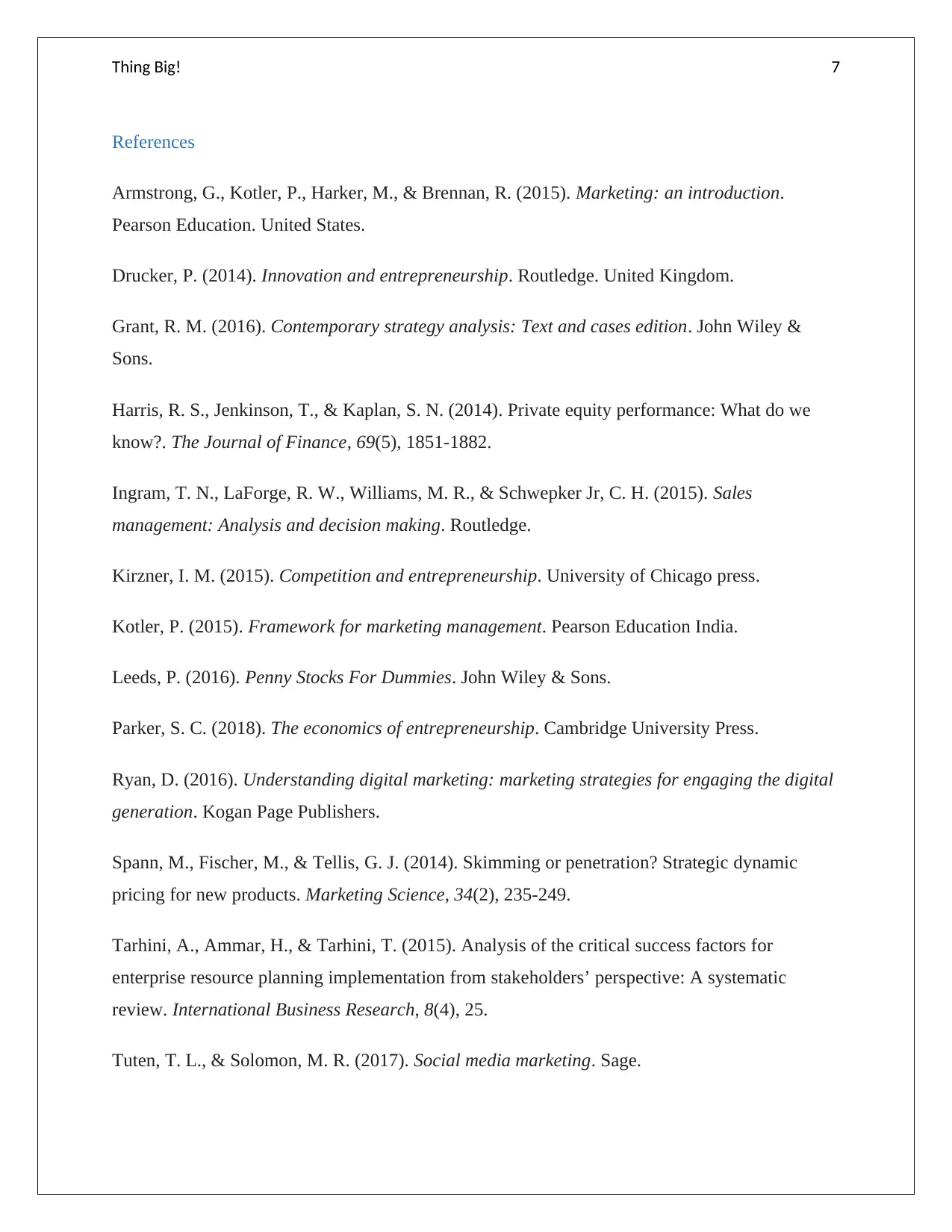
Thing Big! 7
References
Armstrong, G., Kotler, P., Harker, M., & Brennan, R. (2015). Marketing: an introduction.
Pearson Education. United States.
Drucker, P. (2014). Innovation and entrepreneurship. Routledge. United Kingdom.
Grant, R. M. (2016). Contemporary strategy analysis: Text and cases edition. John Wiley &
Sons.
Harris, R. S., Jenkinson, T., & Kaplan, S. N. (2014). Private equity performance: What do we
know?. The Journal of Finance, 69(5), 1851-1882.
Ingram, T. N., LaForge, R. W., Williams, M. R., & Schwepker Jr, C. H. (2015). Sales
management: Analysis and decision making. Routledge.
Kirzner, I. M. (2015). Competition and entrepreneurship. University of Chicago press.
Kotler, P. (2015). Framework for marketing management. Pearson Education India.
Leeds, P. (2016). Penny Stocks For Dummies. John Wiley & Sons.
Parker, S. C. (2018). The economics of entrepreneurship. Cambridge University Press.
Ryan, D. (2016). Understanding digital marketing: marketing strategies for engaging the digital
generation. Kogan Page Publishers.
Spann, M., Fischer, M., & Tellis, G. J. (2014). Skimming or penetration? Strategic dynamic
pricing for new products. Marketing Science, 34(2), 235-249.
Tarhini, A., Ammar, H., & Tarhini, T. (2015). Analysis of the critical success factors for
enterprise resource planning implementation from stakeholders’ perspective: A systematic
review. International Business Research, 8(4), 25.
Tuten, T. L., & Solomon, M. R. (2017). Social media marketing. Sage.
References
Armstrong, G., Kotler, P., Harker, M., & Brennan, R. (2015). Marketing: an introduction.
Pearson Education. United States.
Drucker, P. (2014). Innovation and entrepreneurship. Routledge. United Kingdom.
Grant, R. M. (2016). Contemporary strategy analysis: Text and cases edition. John Wiley &
Sons.
Harris, R. S., Jenkinson, T., & Kaplan, S. N. (2014). Private equity performance: What do we
know?. The Journal of Finance, 69(5), 1851-1882.
Ingram, T. N., LaForge, R. W., Williams, M. R., & Schwepker Jr, C. H. (2015). Sales
management: Analysis and decision making. Routledge.
Kirzner, I. M. (2015). Competition and entrepreneurship. University of Chicago press.
Kotler, P. (2015). Framework for marketing management. Pearson Education India.
Leeds, P. (2016). Penny Stocks For Dummies. John Wiley & Sons.
Parker, S. C. (2018). The economics of entrepreneurship. Cambridge University Press.
Ryan, D. (2016). Understanding digital marketing: marketing strategies for engaging the digital
generation. Kogan Page Publishers.
Spann, M., Fischer, M., & Tellis, G. J. (2014). Skimming or penetration? Strategic dynamic
pricing for new products. Marketing Science, 34(2), 235-249.
Tarhini, A., Ammar, H., & Tarhini, T. (2015). Analysis of the critical success factors for
enterprise resource planning implementation from stakeholders’ perspective: A systematic
review. International Business Research, 8(4), 25.
Tuten, T. L., & Solomon, M. R. (2017). Social media marketing. Sage.

Thing Big! 8
⊘ This is a preview!⊘
Do you want full access?
Subscribe today to unlock all pages.

Trusted by 1+ million students worldwide
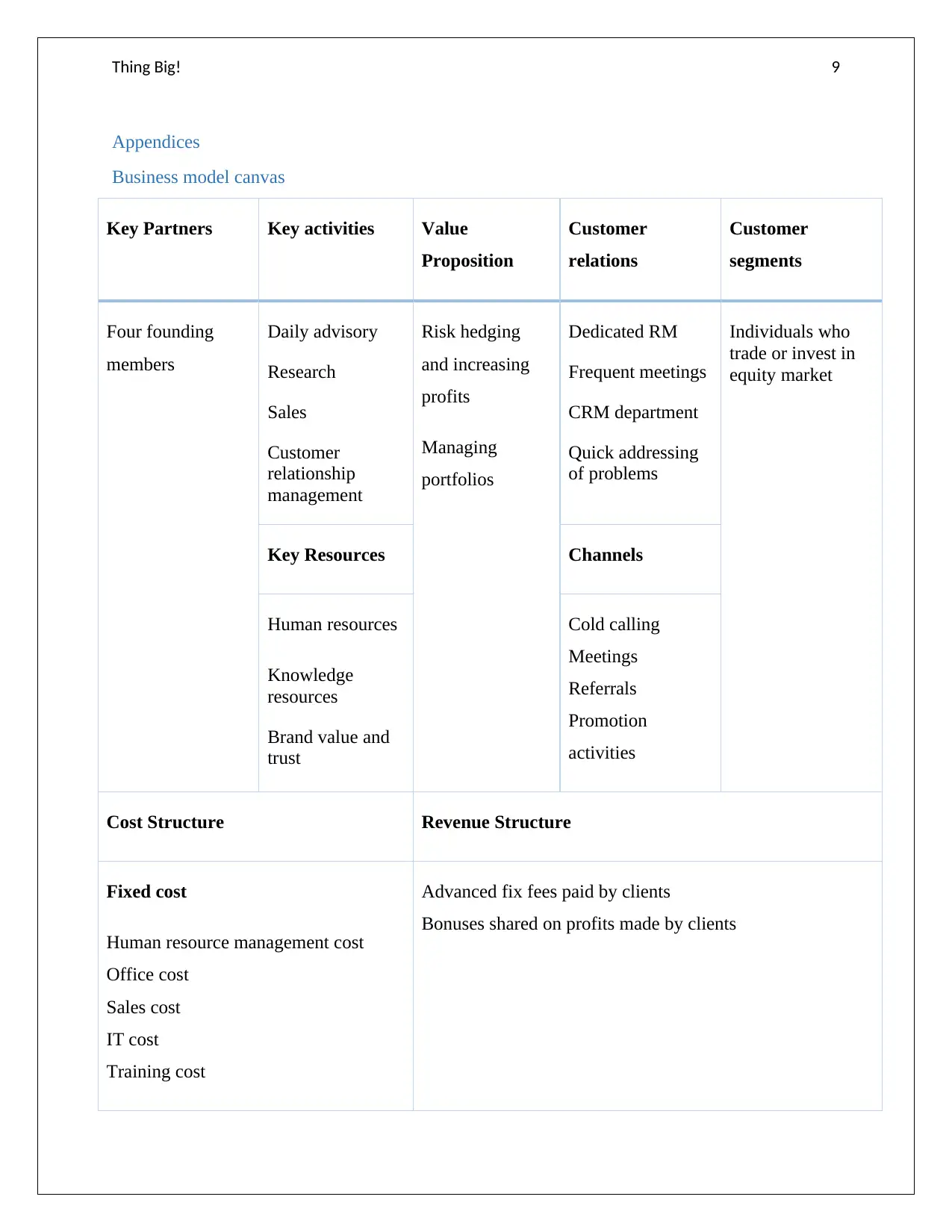
Thing Big! 9
Appendices
Business model canvas
Key Partners Key activities Value
Proposition
Customer
relations
Customer
segments
Four founding
members
Daily advisory
Research
Sales
Customer
relationship
management
Risk hedging
and increasing
profits
Managing
portfolios
Dedicated RM
Frequent meetings
CRM department
Quick addressing
of problems
Individuals who
trade or invest in
equity market
Key Resources Channels
Human resources
Knowledge
resources
Brand value and
trust
Cold calling
Meetings
Referrals
Promotion
activities
Cost Structure Revenue Structure
Fixed cost
Human resource management cost
Office cost
Sales cost
IT cost
Training cost
Advanced fix fees paid by clients
Bonuses shared on profits made by clients
Appendices
Business model canvas
Key Partners Key activities Value
Proposition
Customer
relations
Customer
segments
Four founding
members
Daily advisory
Research
Sales
Customer
relationship
management
Risk hedging
and increasing
profits
Managing
portfolios
Dedicated RM
Frequent meetings
CRM department
Quick addressing
of problems
Individuals who
trade or invest in
equity market
Key Resources Channels
Human resources
Knowledge
resources
Brand value and
trust
Cold calling
Meetings
Referrals
Promotion
activities
Cost Structure Revenue Structure
Fixed cost
Human resource management cost
Office cost
Sales cost
IT cost
Training cost
Advanced fix fees paid by clients
Bonuses shared on profits made by clients
Paraphrase This Document
Need a fresh take? Get an instant paraphrase of this document with our AI Paraphraser

Thing Big! 10
Variable Cost:
Promotion expenses
Variable Cost:
Promotion expenses
1 out of 11
Related Documents
Your All-in-One AI-Powered Toolkit for Academic Success.
+13062052269
info@desklib.com
Available 24*7 on WhatsApp / Email
![[object Object]](/_next/static/media/star-bottom.7253800d.svg)
Unlock your academic potential
Copyright © 2020–2025 A2Z Services. All Rights Reserved. Developed and managed by ZUCOL.





